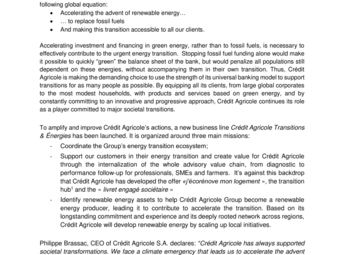
06-12-2022
Crédit Agricole S.A. details its intermediary targets and action plans to reach carbon neutrality by 2050 on 5 sectors
Crédit Agricole S.A. presents today its vision as regards to energy transition, which relies on the following global equation:
- Accelerating the advent of renewable energy…
- … to replace fossil fuels
- And making this transition accessible to all our clients.

Accelerating investment and financing in green energy, rather than to fossil fuels, is necessary to effectively contribute to the urgent energy transition. Stopping fossil fuel funding alone would make it possible to quickly “green” the balance sheet of the bank, but would penalize all populations still dependent on these energies, without accompanying them in their own transition. Thus, Crédit Agricole is making the demanding choice to use the strength of its universal banking model to support transitions for as many people as possible. By equipping all its clients, from large global corporates to the most modest households, with products and services based on green energy, and by constantly committing to an innovative and progressive approach, Crédit Agricole continues its role as a player committed to major societal transitions.
To amplify and improve Crédit Agricole’s actions, a new business line Crédit Agricole Transitions & Énergies has been launched. It is organized around three main missions:
- Coordinate the Group’s energy transition ecosystem;
- Support our customers in their energy transition and create value for Crédit Agricole through the internalization of the whole advisory value chain, from diagnostic to performance follow-up for professionals, SMEs and farmers. It’s against this backdrop that Crédit Agricole has developed the offer «j’écorénove mon logement », the transition hub[1] and the « livret engagé sociétaire »
- Identify renewable energy assets to help Crédit Agricole Group become a renewable energy producer, leading it to contribute to accelerate the transition. Based on its longstanding commitment and experience and its deeply rooted network across regions, Crédit Agricole will develop renewable energy by scaling up local initiatives.
Philippe Brassac, CEO of Crédit Agricole S.A. declares: “Crédit Agricole has always supported societal transformations. We face a climate emergency that leads us to accelerate the advent of green financing, replacing fossil fuels, and to rise to the huge task of making energy transition accessible to all our clients, from large corporates to the most modest households. The trajectory we have chosen is both responsible and demanding.”
CASA is defining ambitious targets to accelerate the transition carbon neutrality in 2050. After having disclosed Net Zero Asset Owner (CA Assurances) and Net Zero Asset Managers (Amundi) commitments, it publishes today 2030 targets on five sectors (Oil & Gas, Automotive, Power, Commercial Real Estate & Cement) for Crédit Agricole S.A. and its subsidiaries within the Net Zero Banking Alliance.
Going forward, Crédit Agricole Group will disclose the targets for five additional sectors (Shipping, Aviation, Steel, Residential Real Estate and Agriculture) in 2023. These commitments are very ambitious, as these ten sectors represent over 75% of global GHG emissions and around 60% of Crédit Agricole Group’s credit exposure. Crédit Agricole has also committed to decrease its own direct carbon footprint by -50% by 2030[2].
The Group’s climate action is in line with its commitment to contribute to global carbon neutrality by 2050, and the Group’s climate strategy fully contributes to its MTP revenue generation targets.
MAIN TARGETS[3]
|
2030[4] Net Zero Banking Alliance targets for Crédit Agricole S.A.
|
|
2030 Net Zero Asset Managers Initiative and Asset Owners alliance targets for Crédit Agricole S.A.
2025 Sectorial Targets
|
- ^ [1] Platform since June 2022, launch in the first quarter 2023 for the Corporates, launch in the second semester 2023 for professionals
- ^ [2] Decrease of Crédit Agricole S.A.’s absolute emissions linked to energy consumption (scopes 1 & 2) and business travels between 2019 and 2030
- ^ [3] Disclaimer: As reference scenarios, data quality and methodologies are constantly evolving, the figures listed below may change over time.
- ^ [4] Vs 2020
- ^ [5] CO2e = CO2 equivalent
- ^ [6] Taking into account scope 1&2 of all counterparts and scope 3 of upstream players, on our on-balance sheet exposure
- ^ [7] CACIB and CAL&F.Taking into account scope 1 & 2 of power producers. On and off- balance sheet exposure considered for the baseline
- ^ [8] CACIB, CACF and CAL&F. Taking into account scope 3 of OEMs (use) and scope 1 of final users, excluding heavy vehicles, EFL and Wafasalaf
- ^ [9] CACIB, LCL, CA Italia and CAL&F.Taking into account use of building, excluding construction. Entities considered CACIB, CAL&F, LCL (real estate professionals)
- ^ [10] Carbon Risk Real Estate Monitor
- ^ [11] On CACIB scope only; on and off-sheet exposure considered for the baseline
- ^ [12] Perimeter excluding JV and fund hosting & advisory mandate
- ^ [13] Target related to carbon footprint of the listed equity and corporate bond investment portfolio managed by Amundi (€127 Bn as of 31/12/2021)
- ^ [14] New and more ambitious target vs target set at -20% in the 2025 MTP
- ^ [15] Exposure at default
- ^ [16] Including climate impact solutions
This document has been prepared by Crédit Agricole S.A. for informational purposes only and is intended to provide non-exhaustive and general information. This document may contain, or incorporate by reference, public information not separately reviewed, approved or endorsed by any entities of Credit Agricole Group and accordingly, no representation, warranty or undertaking, express or implied, is made and no responsibility or liability is accepted by any entities of Credit Agricole Group as to the fairness, accuracy, reasonableness or completeness of such information. None of Credit Agricole Group’s entities or their respective directors, officers, representatives, agents or employees shall have any liability whatsoever in negligence or otherwise for any loss however arising from any use of this document or its contents or otherwise arising in connection with this document or any other information or material discussed. The information in this document has not been independently verified. The sum of values contained in this document may differ slightly from the total reported due to rounding.
Some data have been calculated on basis of new and innovative methodology that may evolve in the future. This document is not intended to be and should not be construed as providing legal or financial advice. It does not constitute an offer or invitation to sell or any solicitation of any offer to purchase or subscribe for any securities and no part of it shall form the basis of or be relied upon in connection with any contract or commitment whatsoever and it has not been approved by any regulatory authority. Any offer of securities, if made, will be made by means of a prospectus, offering memorandum or any other legal documentation, and investors should not subscribe for any securities unless they receive such a prospectus, offering memorandum or any other legal documentation, which they should carefully review in full. Without limiting the foregoing, this document does not constitute an offer to sell, or a solicitation of any offer to purchase or subscribe for securities in the United States or in any other jurisdictions. Notably, any securities referred to herein have not been, and will not be, registered under the Securities Act and may not be offered or sold within the United States or to, or for the account or benefit of, U.S. persons except pursuant to an exemption from, or in a transaction not subject to, the registration requirements of the Securities Act. The Credit Agricole Group does not intend to register any portion of any offering in the United States or to conduct a public offering of securities in the United States. This document is not intended for distribution to, or use by, any person or entity in any jurisdiction or country where such distribution or use would be contrary to law or regulation. Persons who might come into possession of it must inquire as to the existence of any restrictions applicable to them and comply with them. This document may contain forward-looking information and prospective statements that are not historical facts.
None of the future projections, expectations, estimates or prospects in this document should be taken as forecasts or promises nor should they be taken as implying any indication, assurance or guarantee that the assumptions on which such future projections, expectations, estimates or prospects have been prepared are correct or exhaustive or, in the case of the assumptions, fully stated in the document. Crédit Agricole Group undertakes no obligation to update, modify or amend this document or the statements contained herein to reflect actual changes in assumptions or changes in factors or to otherwise notify any addressee if any information, projection, forecast or estimate set forth herein evolves or subsequently becomes inaccurate.
This document has been produced, in particular, on the basis of proprietary and confidential information of Credit Agricole Group and is available on its website https://www.credit-agricole.com/. It shall not be reproduced, redistributed or passed on, directly or indirectly, to any other person or published, in whole or in part, for any purpose, without the prior written consent of Credit Agricole S.A.

Our press contacts

Alexandre Barat
Responsable Relations Presse Crédit Agricole S.A.

Olivier Tassain
Crédit Agricole S.A.

Mathilde DURAND




